Researchers at HSE Centre for Language and Brain Reveal Key Factors Determining Language Recovery in Patients After Brain Tumour Resection

Alina Minnigulova and Maria Khudyakova at the HSE Centre for Language and Brain have presented the latest research findings on the linguistic and neural mechanisms of language impairments and their progression in patients following neurosurgery. The scientists shared insights gained from over five years of research on the dynamics of language impairment and recovery.
The surgical removal of brain tumours located near language areas can result in various postoperative language disorders. Typically, language functions recover in the immediate postoperative period; however, two out of three patients may experience disorders in the chronic phase.
To understand the dynamics of language impairments and recovery after tumour resection, scientists at the HSE Centre for Language and Brain in Moscow and the Centre for Language and Brain Studies in Nizhny Novgorod have been assessing patients using the Russian Aphasia Test (RAT) at three key time points: before surgery, a few days post-surgery, and three to four months later.
By comparing comprehensive language test results with magnetic resonance imaging (MRI) data, it was possible to evaluate the importance of specific grey and white matter areas for language function.
The researchers examined how well key clinical factors—such as postoperative declines in language processing, tumour malignancy, resection volume and location, and the use of intraoperative language mapping—can predict long-term language recovery after surgery. Beyond predicting overall recovery, the researchers identified the brain regions involved in language processing that are most vulnerable to persistent deficits.
Maria Khudyakova, Director of the Centre for Language and Brain Studies at the HSE Campus in Nizhny Novgorod, studied the postoperative restoration of both comprehension and production of individual words: nouns and verbs.
'By testing the comprehension and production of nouns and verbs, we expected to observe a significant decline in performance on all tasks immediately after surgery, followed by a substantial improvement three to four months later. It was interesting to note that while the comprehension and production of nouns did not fully recover to preoperative levels, verbs—terms denoting actions—and the comprehension of all words were restored,' according to Khudyakova.
Maria Khudyakova added that although object naming had not fully recovered to its preoperative level, the naming rate for objects that were correctly identified had increased, meaning they were named more quickly.
Alina Minnigulova, Research Fellow at the HSE Centre for Language and Brain in Moscow, has participated in surgeries since 2017, initially testing patients in Nizhny Novgorod. In 2020, she joined a neurosurgical project in Moscow, which included a study on predictors of language recovery.
‘In 2024, we completed a five-year study on the impact of clinical and behavioural characteristics on language recovery in patients following the resection of glial tumours in the left hemisphere after a delay of three to six months,' explains Minnigulova. 'We found that smaller declines in language test scores and awake surgery involving brain mapping and speech monitoring both predict better language recovery in patients three to six months after surgery.'
Additionally, the scientists determined that verbal working memory and vocabulary retrieval, in particular verbs, are most vulnerable to persistent deficits.
'This study has been completed, but we continue to work with the neurosurgical population, investigating the neural correlations of language disorders, lateralisation, and the specification of language functions,' says Minnigulova.
See also:
Scientists Rank Russian Regions by Climate Risk Levels
Researchers from HSE University and the Russian Academy of Sciences have assessed the levels of climate risks across Russian regions. Using five key climate risks—heatwaves, water stress, wildfires, extreme precipitation, and permafrost degradation—the scientists ranked the country’s regions according to their need for adaptation to climate change. Krasnoyarsk Krai, Irkutsk Region, and Sverdlovsk Region rank among the highest for four of the five climate risks considered. The study has been published in Science of the Total Environment.
HSE Researchers Teach Neural Network to Distinguish Origins from Genetically Similar Populations
Researchers from the AI and Digital Science Institute, HSE Faculty of Computer Science, have proposed a new approach based on advanced machine learning techniques to determine a person’s genetic origin with high accuracy. This method uses graph neural networks, which make it possible to distinguish even very closely related populations.
HSE Economists Reveal the Secret to Strong Families
Researchers from the HSE Faculty of Economic Sciences have examined the key factors behind lasting marriages. The findings show that having children is the primary factor contributing to marital stability, while for couples without children, a greater income gap between spouses is associated with a stronger union. This is the conclusion reported in Applied Econometrics.
Fifteen Minutes on Foot: How Post-Soviet Cities Manage Access to Essential Services
Researchers from HSE University and the Institute of Geography of the Russian Academy of Sciences analysed three major Russian cities to assess their alignment with the '15-minute city' concept—an urban design that ensures residents can easily access essential services and facilities within walking distance. Naberezhnye Chelny, where most residents live in Soviet-era microdistricts, demonstrated the highest levels of accessibility. In Krasnodar, fewer than half of residents can easily reach essential facilities on foot, and in Saratov, just over a third can. The article has been published in Regional Research of Russia.
HSE Researchers Find Counter-Strike Skins Outperform Bitcoin and Gold as Alternative Investments
Virtual knives, custom-painted machine guns, and gloves are common collectible items in videogames. A new study by scientists from HSE University suggests that digital skins from the popular video game Counter-Strike: Global Offensive (CS:GO) rank among the most profitable types of alternative investments, with average annual returns exceeding 40%. The study has been published in the Social Science Research Network (SSRN), a free-access online repository.
HSE Neurolinguists Reveal What Makes Apps Effective for Aphasia Rehabilitation
Scientists at the HSE Centre for Language and Brain have identified key factors that increase the effectiveness of mobile and computer-based applications for aphasia rehabilitation. These key factors include automated feedback, a variety of tasks within the application, extended treatment duration, and ongoing interaction between the user and the clinician. The article has been published in NeuroRehabilitation.
'Our Goal Is Not to Determine Which Version Is Correct but to Explore the Variability'
The International Linguistic Convergence Laboratory at the HSE Faculty of Humanities studies the processes of convergence among languages spoken in regions with mixed, multiethnic populations. Research conducted by linguists at HSE University contributes to understanding the history of language development and explores how languages are perceived and used in multilingual environments. George Moroz, head of the laboratory, shares more details in an interview with the HSE News Service.
Slim vs Fat: Overweight Russians Earn Less
Overweight Russians tend to earn significantly less than their slimmer counterparts, with a 10% increase in body mass index (BMI) associated with a 9% decrease in wages. These are the findings made by Anastasiia Deeva, lecturer at the HSE Faculty of Economic Sciences and intern researcher in Laboratory of Economic Research in Public Sector. The article has been published in Voprosy Statistiki.
Scientists Reveal Cognitive Mechanisms Involved in Bipolar Disorder
An international team of researchers including scientists from HSE University has experimentally demonstrated that individuals with bipolar disorder tend to perceive the world as more volatile than it actually is, which often leads them to make irrational decisions. The scientists suggest that their findings could lead to the development of more accurate methods for diagnosing and treating bipolar disorder in the future. The article has been published in Translational Psychiatry.
Scientists Develop AI Tool for Designing Novel Materials
An international team of scientists, including researchers from HSE University, has developed a new generative model called the Wyckoff Transformer (WyFormer) for creating symmetrical crystal structures. The neural network will make it possible to design materials with specified properties for use in semiconductors, solar panels, medical devices, and other high-tech applications. The scientists will present their work at ICML, a leading international conference on machine learning, on July 15 in Vancouver. A preprint of the paper is available on arxiv.org, with the code and data released under an open-source license.




